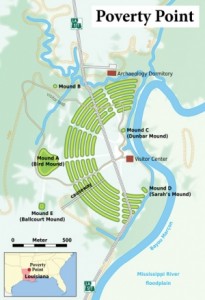
While not as closely watched as the World Cup in Brazil, for those who care about international heritage the 38th session of the World Heritage Committee in Doha, Qatar (June 15-25, 2014) was an important event. Among the highlights were the inscriptions of the 1,000th World Heritage Site, the Okavango Delta in Botswana, and Myanmar’s first property on the World Heritage List. During its ten-day meet up, the Committee added a total of 26 new sites the List to bring the number of World Heritage Sites to 1007, in 161 countries.
Representatives from the United States (US) were there to follow the voting on the Monumental Earthworks of Poverty Point. This was country’s first World Heritage nomination since the US withdrew the its support for UNESCO. See US World Heritage Program at Risk Score one for team US. On June 22, 2014, the nomination for Poverty Point was inscribed as the 1,001st property on the World Heritage List.
(However, see the comment below – it turns out it was a very close game!)
Listed under Criteria iii, the site was determined to bear a unique or at least exceptional testimony to a cultural tradition or to a civilization which is living or which has disappeared. The monumental prehistoric earthwork complex is located in Louisiana’s Lower Mississippi Valley. It was part of a trading network 3,000 years ago that stretched hundreds of miles across the North American continent. Poverty Point is a remarkable system of monumental mounds and ridges that were built into the landscape for residential and ceremonial use by a sophisticated society of hunter-fisher-gatherers. It is a masterpiece of engineering from its time as the major political, trading, and ceremonial center of North America.
Not scoring so well was Australia; although the committee deferred for 12 months a decision on whether to place Australia’s Great Barrier Reef on the List of World Heritage in Danger, the Committee expressed concerns over planned coastal developments, including development of ports and liquefied natural gas facilities. It asked Australia to submit an updated report on the state of conservation of the reef by 1 February 2015. In addition the World Heritage Committee rejected the Australian Government ‘s proposal to delist 74,000 of hectares from the boundaries of the Tasmanian Wilderness. It was reported that the current government of Australia lobbied the delegates in Doha unsuccessfully to get more flexibility in the management of these iconic resources.http://www.theaustralian.com.au/national-affairs/opinion/confused-grief-over-great-barrier-reef/story-e6frgd0x-1226961709198
Scoring points for good deeds was the host state of Qatar. The Prime Minister of Qatar opened the meeting by announcing a donation to the World Heritage Center of $10 million to establish a new fund to assist World Heritage sites affected by conflict or natural disaster. He called on “all of the states in the big World Heritage family” to contribute to this fund. To see some the challenges view Culture under Attack: A Photo Exhibition on Cultural Heritage and Armed Conflict.



One Response
From:
Stephen Morris
Chief
Office of International Affairs
National Park Service
Dear Colleagues:
Many have expressed interest in the World Heritage Committee’s decision to inscribe Louisiana’s Poverty Point on the World Heritage List at its recently concluded session in Doha, Qatar. The ICOMOS evaluation report endorsed the Outstanding Universal Value of Poverty Point, and praised many aspects of the nomination document, but recommended “deferral” of the nomination for two reasons. ICOMOS expressed concern about protection of the area outside the boundary because no specific buffer zone was proposed, and objected to the road that passes through the site.
The Department of the Interior and the National Park Service collaborated closely with the State of Louisiana and the State Department to compile a concise response addressing those concerns, which were based in part on incorrect premises. The attached summary was accompanied by images and other supporting documents, and was provided to all 21 countries on the World Heritage Committee.
At the Committee session, ICOMOS made a presentation of their findings. Many Committee members expressed support for the nomination, but also requested the U.S. to take the floor to respond to the issues raised. Acting Assistant Secretary Rachel Jacobson made a brief but compelling statement summarizing our points. The Committee then made the decision to inscribe by consensus. We were very pleased with the outcome.
Best regards,
Steve
Stephen Morris
Chief
Office of International Affairs
National Park Service
1201 Eye Street, NW
Washington, DC 20005
Stephen_Morris@nps.gov
(202) 354-1803
Fax (202) 371-1446